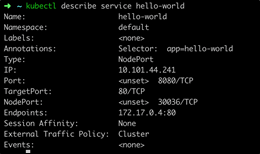This is part of our Kubernetes Guide. Browse for other relevant topics and how-to’s using the right-hand menu.
Port configurations for Kubernetes Services
In Kubernetes there are several different port configurations for Kubernetes services:
- Port exposes the Kubernetes service on the specified port within the cluster. Other pods within the cluster can communicate with this server on the specified port.
- TargetPort is the port on which the service will send requests to, that your pod will be listening on. Your application in the container will need to be listening on this port also.
- NodePort exposes a service externally to the cluster by means of the target nodes IP address and the NodePort. NodePort is the default setting if the port field is not specified.
Let’s look at how to use these ports in your Kubernetes manifest.
Using Port, TargetPort, and NodePort
apiVersion: v1 kind: Service metadata: name: hello-world spec: type: NodePort selector: app: hello-world ports: - protocol: TCP port: 8080 targetPort: 80 nodePort: 30036
From the above examples the hello-world service will be exposed internally to cluster applications on port 8080 and externally to the cluster on the node IP address on 30036. It will also forward requests to pods with the label “app: hello-world” on port 80.
The configuration of the above settings can be verified with the command:
$ kubectl describe service hello-world

Create a pod running nginx to which the service will forward requests to:
apiVersion: v1 kind: Pod metadata: name: nginx labels: app: hello-world spec: containers: - name: nginx image: nginx ports: - containerPort: 80
To test and demonstrate the above configuration, we can create a pod running an ubuntu container to execute some curl commands to verify connectivity.
$ kubectl run -i --tty ubuntu --image=ubuntu --restart=Never -- sh
From this pod run the following commands:
Curl the service on the ‘port’ defined in the Kubernetes manifest for the service.
$ curl hello-world:8080
This proves that curling the Kubernetes service on port 80 forwards the request to our nginx pod listening on port 80.
To test the NodePort on your machine (not in the ubuntu pod) you will need to find the IP address of the node that your pod is running on.
$ kubectl describe pod nginx

Now, you can curl the Node IP Address and the NodePort and should reach the nginx container running behind the Kubernetes service.
Additional resources
For more on Kubernetes, explore these resources:






